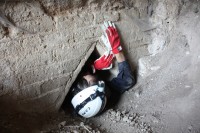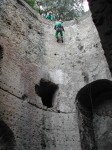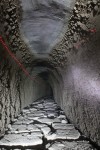 Amateur archaeologists and speleologists from Roma Sotterranea, an organization dedicated to the exploration and documentation of Rome’s many subterranean layers, have discovered previously unknown tunnels underneath Hadrian’s Villa in Tivoli. Archaeologists have long known that there was an elaborate tunnel network under the palace complex, but the passageways which once bustled with the activities of slaves, merchants and ox carts had been filled with soil for years. This is the first time cavers were deployed in an attempt to explore these spaces.
Amateur archaeologists and speleologists from Roma Sotterranea, an organization dedicated to the exploration and documentation of Rome’s many subterranean layers, have discovered previously unknown tunnels underneath Hadrian’s Villa in Tivoli. Archaeologists have long known that there was an elaborate tunnel network under the palace complex, but the passageways which once bustled with the activities of slaves, merchants and ox carts had been filled with soil for years. This is the first time cavers were deployed in an attempt to explore these spaces.
 The spelunking experts rappelled into the tunnels through light shafts. They had to clear bucket after bucket of dirt out of passageways, many of which were so narrow they barely had the space for a grown human to squeeze through. After clearing some of the access tunnels, the team found a new passageway leading from a remote area of the villa known as the Academy to a major underground tunnel 2.5 miles long called the Grande Trapezio. The newly discovered tunnel is seven feet wide and a half mile long. It runs north-east and then turns south, ending in a roundabout about 766 yards long which may have been used to turn around ox carts.
The spelunking experts rappelled into the tunnels through light shafts. They had to clear bucket after bucket of dirt out of passageways, many of which were so narrow they barely had the space for a grown human to squeeze through. After clearing some of the access tunnels, the team found a new passageway leading from a remote area of the villa known as the Academy to a major underground tunnel 2.5 miles long called the Grande Trapezio. The newly discovered tunnel is seven feet wide and a half mile long. It runs north-east and then turns south, ending in a roundabout about 766 yards long which may have been used to turn around ox carts.
Another uncharted tunnel the cavers discovered is more than 16 feet wide, wide enough for two-way traffic without needing a roundabout. It is still filled with soil and debris almost to the ceiling. Team members have attempted to inch their way through the tunnel on their stomachs, but they haven’t been able to follow its length so we still don’t know where it leads or what buildings it serviced when it was active.
 Neither of these tunnels were included in ancient plans of the villa. Historians still don’t know the full extent of this vast estate. The site today is around the 120 hectares (296 acres) in area, but archaeologists believe it may have been as large as 250 hectares when Hadrian had it built starting when he became emperor in 117 A.D. and continued through to his death in 138 A.D. The discovery of these tunnels in a relatively remote area of the complex provides important information about the extent of above-ground structures that have long since been destroyed by time, the elements, and the ever-present stone looters that dismantled so much of antiquity to make new buildings like the nearby Villa d’Este built by Cardinal Ippolito II d’Este in the 16th century.
Neither of these tunnels were included in ancient plans of the villa. Historians still don’t know the full extent of this vast estate. The site today is around the 120 hectares (296 acres) in area, but archaeologists believe it may have been as large as 250 hectares when Hadrian had it built starting when he became emperor in 117 A.D. and continued through to his death in 138 A.D. The discovery of these tunnels in a relatively remote area of the complex provides important information about the extent of above-ground structures that have long since been destroyed by time, the elements, and the ever-present stone looters that dismantled so much of antiquity to make new buildings like the nearby Villa d’Este built by Cardinal Ippolito II d’Este in the 16th century.
“These tunnels lead us to understand that Hadrian’s Villa was organised less like a villa and more like a city,” said Benedetta Adembri, the director of the site, who is planning, in the autumn, to open stretches of the tunnels to the public for the first time.
 Much of that city was underground, ensuring that the emperor could enjoy the illusion of complete privacy without having to see, hear or even notice the platoons of slaves and carters and beasts of burden that clogged the street-level arteries of actual cities. Now that so much of the above-ground complex has been lost, these tunnels, specifically created to keep all the bustle of daily operations out of view, are now archaeological superstars because they are still in excellent condition thanks to having been filled with debris and ignored for centuries.
Much of that city was underground, ensuring that the emperor could enjoy the illusion of complete privacy without having to see, hear or even notice the platoons of slaves and carters and beasts of burden that clogged the street-level arteries of actual cities. Now that so much of the above-ground complex has been lost, these tunnels, specifically created to keep all the bustle of daily operations out of view, are now archaeological superstars because they are still in excellent condition thanks to having been filled with debris and ignored for centuries.